 Customer Engagement
Customer Engagement

04 March, 2023
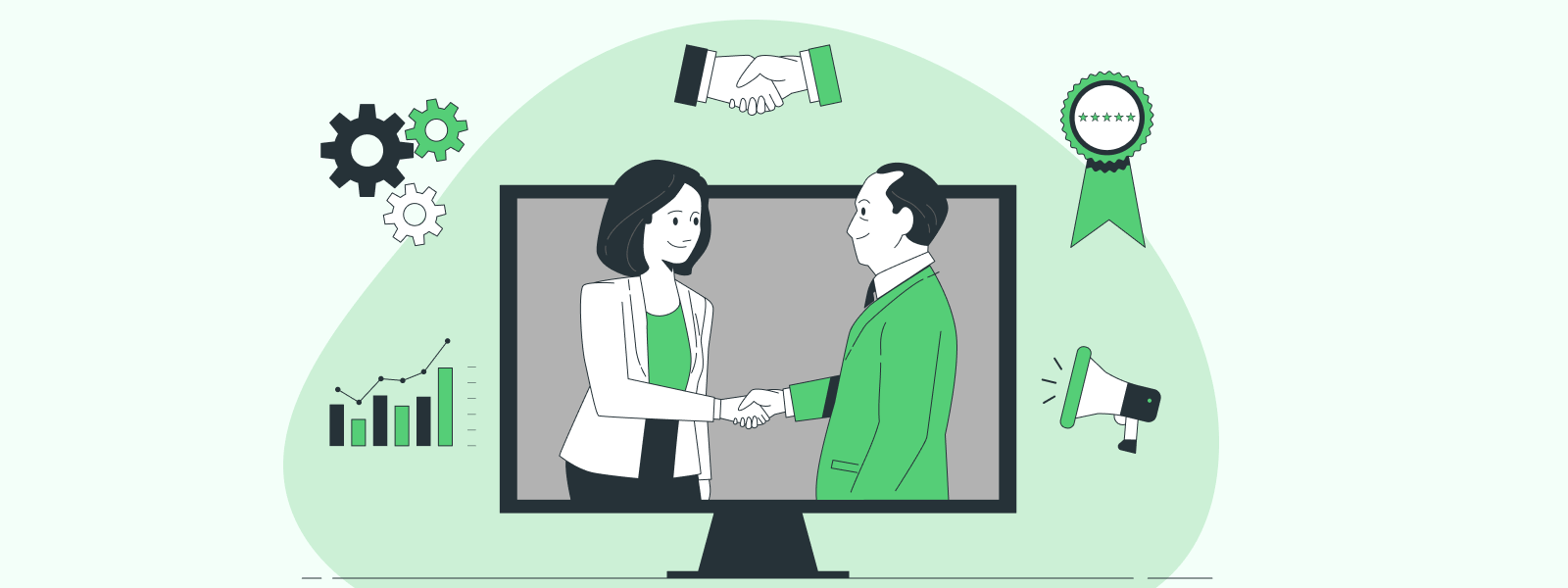
Are you looking for ways to build stronger relationships with your customers? Is your organization struggling with lower customer retention rates and sales? Are you confused about where to start building customer engagement due to multiple channels?
If any of the answers to the questions mentioned above is yes, this is an essential blog for you to go through. As the world approaches digitalization, businesses are focusing more on customer engagement to stand out from their competition.
Here is my comprehensive guide to mastering customer engagement to help your business engage customers better and increase customer retention and sales. I will discuss the best practices and strategies to build customer engagement and the tools and metrics you will need.
Let’s discuss this in detail.
Contents
Customer engagement refers to the ongoing process of building and maintaining a solid relationship with consumers through meaningful experiences and interactions. In short, as a business owner, you will need to understand your customers’ behaviors and use that information to create personalized experiences for them to meet their expectations.
As new businesses are emerging every day, it is crucial for businesses to build strong customer engagement to stay ahead. This builds trust, loyalty, and advocacy for businesses, driving long-term growth and success.
Consumers have numerous options to choose from for their necessary products and services. Therefore businesses need to interact with their customers through a variety of channels to strengthen relationships. Ideally, as a business owner, you will need to begin the process with the first interaction and extend beyond the point of purchase.
With this process, you offer your customer value beyond your products and services. While your exceptional products and services attract your customers: relevant content keeps them interested.
If you are trying to build better customer engagement, you will need a strategy that outlines how to communicate with your customers, meet their needs, and build long-term relationships.
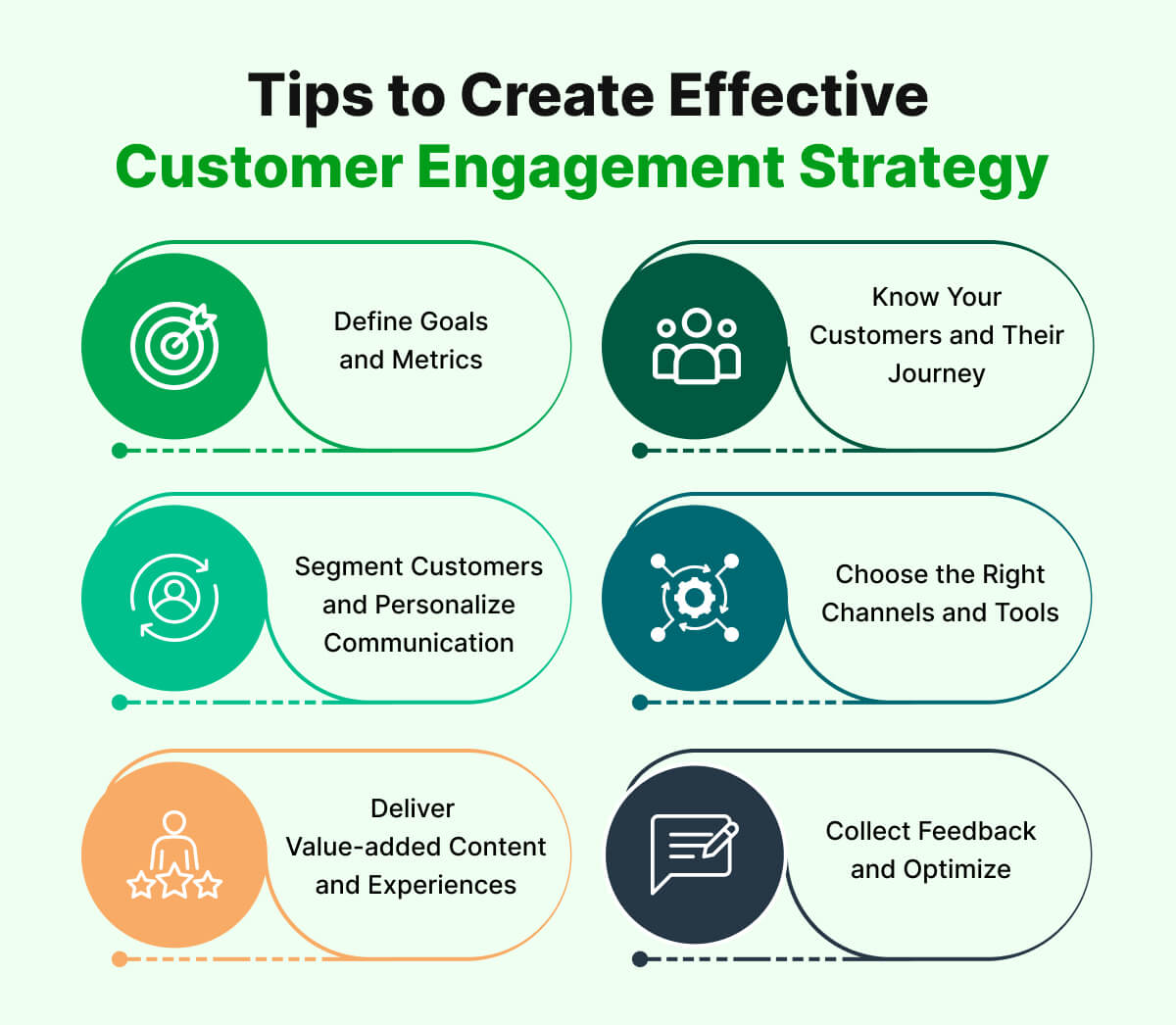
So, how do you create a customer engagement strategy for your business? Here are some steps you can follow:
Remember, a customer engagement strategy is not a one-time project. You must constantly update, monitor, evaluate, improve, and improvise your engagement strategy. Only then you can create a strategy that strengthens your relationship with the consumers and grows your business.
The next concern I’m going to address is how you can build a better customer engagement strategy. Even seasoned business owners can struggle in this manner. However, this process can be fairly straightforward with a customer engagement tool.
Customer engagement tools are applications and software helping businesses interact with their customers in personalized and meaningful ways. These applications and software can collect feedback, provide support, send notifications, offer rewards, and more.
Nowadays, several types of customer engagement tools are available. Chatbots, surveys, loyalty programs, push notifications, and virtual assistants are some glowing examples of customer engagement tools.
When businesses use these tools effectively and strategically can gain the following benefits:
Overall, these tools help you to gather better insights and generate better relationships with your audience in a personalized manner. This helps your business to generate a better bottom line and engagement.
As mentioned above, numerous customer engagement tools are available nowadays, which can be overwhelming. So, here is a comparison of different tools for your convenience.
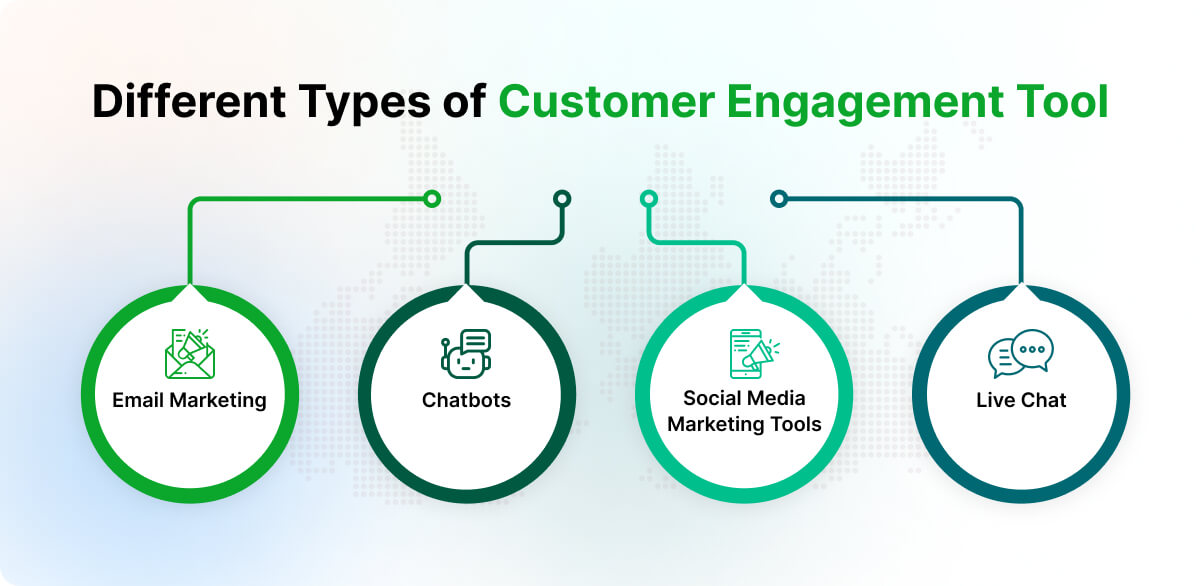
One of the oldest and most widely used customer engagement tools is email marketing. With email marketing tools, businesses can send personalized customer messages based on preferences, behavior, and purchase history.
This also helps in increasing brand awareness, loyalty, and conversions. However, email marketing contains some drawbacks. Low open rates, unsubscribes, and spam filters are some of the significant drawbacks of this tool.
MailChimp, NotifyVisitors, Sendinblue, and SendPulse are some of the leading email marketing tools.
One of the growing customer engagement tools is chatbots, which are becoming popular by the minute. Chatbots are artificial intelligence-powered software applications that simulate human conversations through text or voice.
Chatbots help businesses to automate repetitive tasks like answering FAQs, booking appointments, and collecting feedback. It can also offer personalized recommendations based on customer data and preferences.
Additionally, they are cost-effective, available 24/7, and scalable. Hubspot Chatbot Builder, REVE Chat, Drift, and Intercom are some of the popular chatbots used widely.
However, chatbots may pose several challenges, including technical complexity, ethical concerns, and compromised user expectations.
There has been significant growth in social media in the last decade. These platforms have become a popular way to engage customers online. Businesses can share content on these platforms to attract and entertain their target audience.
With the help of social media, businesses can boost their visibility and brand image. In this manner, social media marketing tools can significantly help. It will give you insights into what campaigns are working better, how much engagement your business is generating, and what else you can do to perform better.
However, social media marketing requires a lot of time and resources to generate engagement. Also, these platforms change their policies and algorithms, which can affect campaign performance.
Live chat allows businesses to communicate with their customers in real-time through their app or website. This way, you can instantly offer support to your customer, answer their queries, and resolve issues.
This is an incredible way to increase customer satisfaction, trust, and retention. However, live chat is quite expensive, contains availability issues, and lacks scalability. Tidio, Chatra, Whistle Messaging, and REVEChat are some excellent tools for live chat.
In a nutshell, different customer engagement tools come with different advantages and weaknesses. So, while choosing your tool, consider the following factors:
Considering all these factors, chatbots are one of the leading customer engagement tools nowadays. These tools offer versatility, efficiency, and innovation. However, you must design these tools and test them carefully.
Now you know how to start your customer engagement strategy and the tools you can use. Here are some additional factors you need to consider.
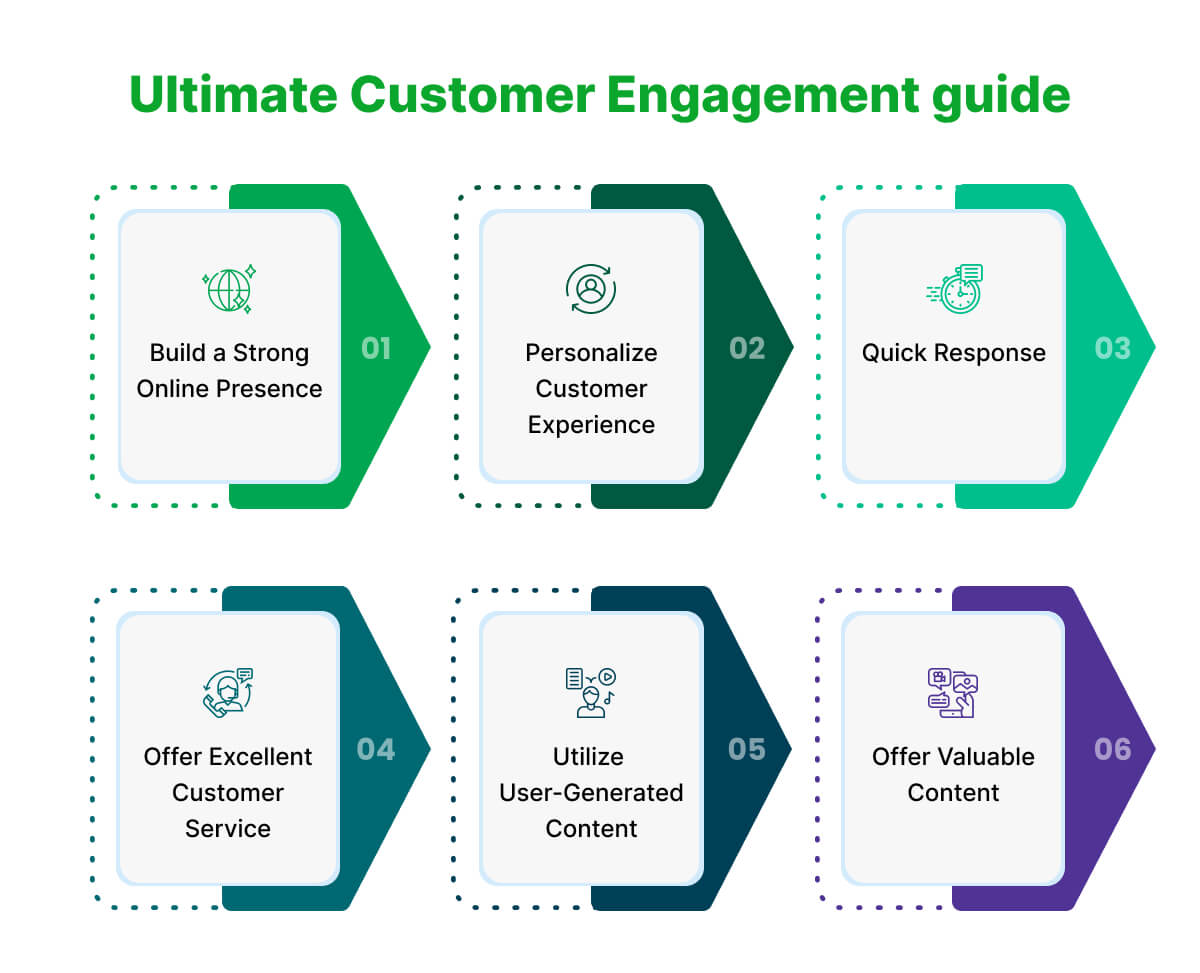
The first thing you will need for your customer engagement is a strong online presence. Your online presence refers to how you showcase your brand, products, and services online. It includes your website, social media accounts, blog posts, videos, podcasts, webinars, reviews, testimonials, and any other content you create or share online.
Your online presence is the virtual storefront that attracts potential customers and convinces them to buy from you. But how do you build a strong online presence that engages your customers in 2023? Here are some tips to help you:
Personalization is the process of tailoring your products, services, content, offers, and interactions to each individual customer based on their data, behavior, feedback, and preferences. Personalization helps you deliver relevant and valuable experiences that make your customers feel understood, valued, and satisfied.
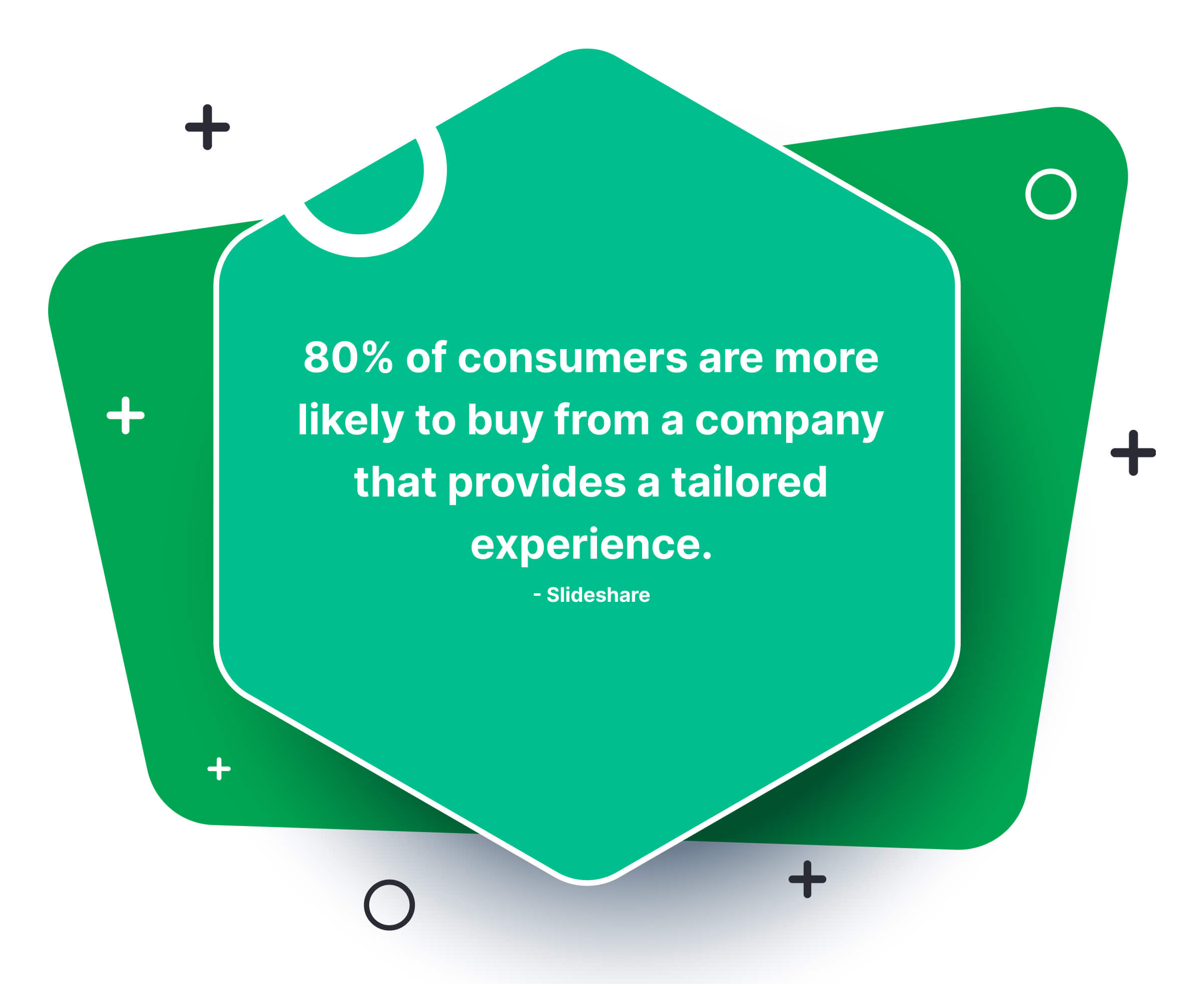
But personalization is not a one-size-fits-all solution. It requires a strategic approach considering your business goals, customer segments, channels, data sources, tools, and metrics.
Here are the steps you can utilize to generate a personalized customer experience:
Define your personalization goals and objectives
With these steps you can curate a phenomenal personalized experience for your audience.
For generating an engaged consumer base, it is crucial that you respond to your consumer within the shortest time possible. How quickly you respond to your customer’s feedback, inquiries, and complaints can hugely impact your brand image and bottom line.
According to a study by HubSpot, 90% of customers rate an immediate response (within 10 minutes) as important or very important when they have a customer service question. Moreover, 82% of customers say that resolving their issues quickly is the most important factor in a great customer service experience.
So, here are some tips on how you can reduce your response time:
Responding quickly to your customers is not only a good practice but also a competitive advantage.
Customer service is one of the most important aspects of customer engagement, especially in 2023. Customers expect fast, personalized, and seamless support across multiple channels.
According to a recent survey by Zendesk, 87% of customers said that good customer service made them more likely to buy from a company again, while 66% said that bad customer service made them switch to a competitor. (Source)
Therefore, offering excellent customer service is essential for building long-term customer relationships and increasing their lifetime value. Here are some best practices for offering excellent customer service:
Customer service is not just a cost center but a revenue driver that can boost your brand reputation, retention rate, and profitability. You can significantly increase customer engagement and gain a competitive edge by offering excellent customer service.
User-generated content is any content created by your customers or fans that showcases your products or services, such as reviews, testimonials, photos, videos, or social media posts. UGC can help you increase your trustworthiness, authenticity, and social proof, as well as generate more organic traffic and conversions.
According to a report by Stackla, 79% of consumers say UGC highly impacts their purchasing decisions. (source)
But how to leverage UGC to enhance customer engagement strategy? Here are some tips to get you started:
User-generated content is a powerful way to connect with your customers and grow your brand in 2023. These tips can help you create a customer engagement strategy leveraging UCG to deliver value, trust, and customer satisfaction.
Last but not least, you will need to include valuable content that educates, entertains, inspires, or solves your audience’s problems. Content can take various forms, like blogs, podcasts, videos, e-books, newsletters, infographics, social media posts, testimonials, and more.
Here are the ways you can create and deliver valuable content that resonates with your target audience:
Before you create any content, you need to understand who your ideal customers are, what their needs and pain points are, what their goals and aspirations are, what their preferences and behaviors are, and how they consume content. You can use interviews, surveys, analytics, and personas to gather this information and segment your audience into different groups based on their characteristics.
Next, you need to determine the goal of your content marketing strategy. Do you want to raise awareness of your brand or product? Do you want to generate leads or sales? Do you want to educate or entertain your customers? Do you want to build trust or authority? Do you want to increase loyalty or advocacy? Your objectives will guide your content creation and distribution decisions.
Based on your audience’s needs, pain points, and objectives, you need to brainstorm topics that interest and benefit your customers. You can use tools like keyword research, competitor analysis, social listening, and customer feedback to determine what topics are popular and relevant in your niche.
Once you have your topics, you start to create informative, engaging, and actionable content. You should use clear, concise language matching your brand voice and tone. Use compelling headlines and subheadings that capture attention and convey value. Also, use visuals such as images, videos, or graphs to enhance readability and appeal. Include data or stories to support your claims or arguments. Finally, use calls-to-action (CTAs) to prompt the customers to take the next step in their journey.
After creating content, distribute it across various channels for your customers to find it. You can use platforms like websites, blogs, email newsletters, social media networks, podcast directories, video hosting sites, ebook stores, and more. You can also promote content using SEO (search engine optimization) strategies, PPC (pay-per-click) advertising, social media marketing, influencer marketing, content syndication, guest posting, and more.
Finally, track and analyze how well your content performs against your objectives. Use metrics such as traffic, reach, cost per click (CPC), click-through rate (CTR), conversion rate, bounce rate, time on page, social shares, email opens, email clicks, and more. Collect feedback from your customers using methods such as surveys, reviews, ratings, testimonials, and comments. Based on these insights, identify what works well and needs improvement, and adjust accordingly.
In conclusion, as a business owner, you need to improve customer engagement if you want to stay ahead of the competition.
To master customer engagement, you must follow some best practices, such as knowing your customer journey, creating a loyalty program, offering personalized service, implementing a chatbot, and using analytics and visualization tools. These practices will help you deliver value to your customers and drive results for your business.